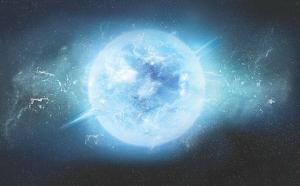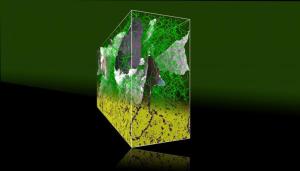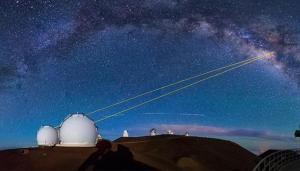LAB REPORT
Science and Technology Making Headlines
Oct. 9, 2020


LLNL scientists have recreated pressures inside the lab similar to what is found in a white dwarf, the faint dense remnant of a star.
White dwarf is under a lot of pressure
Much of the matter inside planets and stars exists in forms unlike anything we encounter on Earth. Chemical bonds start to be ripped apart at pressures above 1 Mbar (a million times the atmospheric pressure at Earth’s surface, but less than a third of the pressure at the planet’s core, and an even smaller fraction of the pressure inside a star). Above 100 Mbar, atoms of carbon and its neighboring elements start to lose even their core electrons and inevitably influence material properties, such as how much a material compresses in response to additional pressure, and thus complicate the interpretation of astero-seismology measurements.
For the first time in a laboratory experiment, researchers working at Lawrence Livermore National Laboratory’s National Ignition Facility (NIF) have measured material compressibility at pressures exceeding 100 Mbar. The team used NIF’s powerful lasers to deliver a megajoule of energy in a 5-nanosecond pulse to a solid sphere 2 millimeters in diameter. The lasers launched a spherical shock wave that converged on the sphere’s center and reached pressures up to 450 Mbar.
Because the sphere was made of a carbonaceous material, its compression mimicked the conditions in the outer envelope of a carbon-rich white dwarf — the faint, dense remnant of a main-sequence star that has exhausted its hydrogen fuel but has insufficient mass to fuse carbon and oxygen into heavier elements. Like other stars, white dwarfs can pulsate and be probed, and the convective outer envelope is the region most responsible for their pulsation modes.


A shuttered asbestos mine site on San Benito Mountain, near Coalinga, California. Photo by Roger Aines/LLNL.
Mineral waste grabs CO2
Scientists are exploring ways to use mineral waste including asbestos from mines to pull huge amounts of carbon dioxide out of the air.
The vast surface area of certain types of fibrous asbestos, a class of carcinogenic compounds once heavily used in heat-resistant building materials, makes them particularly good at grabbing carbondioxide molecules dissolved in rainwater or floating through the air.
That includes the most common form of asbestos, chrysotile, a serpentine mineral. The reaction with carbon dioxide mainly produces magnesium carbonate minerals like magnesite, a stable material that could lock away the greenhouse gas for millennia. Scientists are exploring ways to accelerate these otherwise slow reactions in hopes of using mining waste to fight climate change.
“This is the giant, untapped opportunity that could remove enormous amounts of CO2,” said Roger Aines, head of the Carbon Initiative at Lawrence Livermore National Lab.


To understand exactly how metals respond to high-rate compression in molecular dynamics simulations, LLNL scientists use novel methods of in silico microscopy to reveal defects in the crystal lattice (green and red line objects and gray surface objects at the top) while removing all the atoms (yellow balls at the bottom) for clarity.
Metal mystery is a strain
To solve a 100-year puzzle in metallurgy about why single crystals show staged hardening while others don't, Lawrence Livermore National Laboratory (LLNL) scientists took it down to the atomistic level.
For millennia, humans have exploited the natural property of metals to become stronger or harden when mechanically deformed. Ultimately rooted in the motion of dislocations, mechanisms of metal hardening have remained in the crosshairs of physical metallurgists for more than a century.
The team headed by LLNL materials scientist Vasily Bulatov performed atomistic simulations at the limits of supercomputing that are sufficiently large to be statistically representative of macroscopic crystal plasticity yet fully resolved to examine the origins of metal hardening at its most fundamental level of atomic motion. The simulations were performed on the Vulcan and Lassen supercomputers at Livermore and Mira supercomputer at Argonne Laboratory Computational Facility.
The team demonstrated that the notorious staged (inflection) hardening of metals is a direct consequence of crystal rotation under uni-axial straining. At odds with widely divergent and contradictory views in the literature, researchers found that the basic mechanisms of dislocation behavior are the same across all stages of metal hardening.


It’s just like working at a national lab
Lawrence Livermore National Laboratory (LLNL) will provide significant computing resources to students and faculty from nine universities that were newly selected for participation in the National Nuclear Security Administration (NNSA)’s Predictive Science Academic Alliance Program (PSAAP).
The recipients will form centers focused on application problems relevant to NNSA. It marks the third phase of the PSAAP program. Each of the centers, including their graduate students, postdocs and faculty members, will have access to unclassified supercomputers at LLNL for their funded PSAAP III.
The primary focus of PSAAP III will be to develop and validate large-scale physics simulation codes for heterogeneous architectures, specifically for exascale systems (emerging supercomputers capable of at least a quintillion operations per second) research. The universities also will send students to the three NNSA laboratories (LLNL, Los Alamos and Sandia national laboratories) for internships during the centers’ tenure.
“Through the PSAAP III centers, students will be exposed to working environments similar to what they would experience at a national laboratory, collaborating with interdisciplinary teams on high performance computing modeling and simulation,” said Deputy Division Leader for LLNL’s Center for Applied Scientific Computing Ana Kupresanin, PSAAP representative from LLNL.


The Keck I and Keck II laser guide stars training on the black hole at the center of the Milky Way. Researcher Andrea Ghez used the Keck guide star to conduct her Nobel-winning work. Image courtesy of Keck Observatory.
A Nobel collaboration
The 2020 Nobel Prize in physics has been awarded to Andrea Ghez of the University of California, Los Angeles, and Reinhard Genzel of the Max Planck Institute for Extraterrestrial Physics, for their discovery of the black hole at the center of the Milky Way galaxy. They share the award with Roger Penrose of Oxford University for his mathematical proof that black holes are an inevitable consequence of general relativity.
Ghez has close ties with Lawrence Livermore National Laboratory (LLNL) beginning with her work at the Lick Observatory on Mount Hamilton. At the W.M. Keck Observatory in Hawaii, the adaptive optics (AO) systems on those telescopes dramatically sped up the process of making the intricate observations of stellar orbits needed to infer the presence of the supermassive black hole at the galactic center.
In the 1990s, she and LLNL scientist Scot Olivier and former LLNL scientists Claire Max and Bruce Macintosh were instrumental in standing up the Center for Adaptive Optics. The center’s goal was to lead the revolution in AO by developing and demonstrating the technology, creating major improvements and catalyzing advances nationwide. LLNL had a lead role in the development of the instruments and Ghez had a lead role in the use of those instruments for astronomy.





